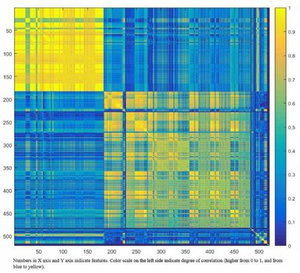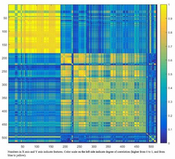Information
- Publication Type: Master Thesis
- Workgroup(s)/Project(s): not specified
- Date: 2023
- Open Access: yes
- First Supervisor: Renata Raidou

- Pages: 97
- Keywords: Visual Analytics, Radiomics, Tumor Segmentation
Abstract
In recent years, radiomics has revolutionized the clinical assessment of tumors. By extracting quantitative features from medical images, this approach provides an objective analysis of tumorous tissues, which ultimately aids medical experts in decision-making processes regarding diagnosis and treatment. However, radiomics is highly dependent on the quality of tumor segmentation. Different tumor delineations resulting from intra- and interobserver variability may significantly affect the results of radiomics analysis. To our knowledge, no prior research has been conducted on the impact of interobserver differences in tumor segmentations on radiomic analytics.This thesis aims to investigate how different tumor segmentations influence radiomics analysis. We therefore design and propose the visual analytics tool ProSeRa (Probabilistic Segmentation on Radiomics), which provides visual analytics strategies for exploring the impact of probabilistic tumor segmentation on radiomics. We empower the users to examine the results of our radiomics analysis with respect to clinical data based on segmentation accuracy thresholds, which we calculate based on the observers’ agreement. We provide ways to explore and analyze the radiomics data using, among others, dimensionality reduction algorithms and cluster analysis mechanisms in conjunction with effective and expressive visualizations. ProSeRa facilitates the assessment of the robustness of the radiomics analysis and supports the exploration of the impact of segmentation on the analysis. Based on the evaluation of our results, we conclude that, as anticipated, variability intumor segmentations considerably influences the radiomics analysis results. The impactwas especially prominent in the cluster analysis, which provided different outcomes fordifferent segmentation accuracy thresholds. Thereby, we detected additional variables, such as the overall tumor stage, being crucial for grouping patients into clusters.
Additional Files and Images
Additional images and videos
Additional files
Weblinks
BibTeX
@mastersthesis{duong-2023-ieo,
title = "Investigating the Effect of Tumor Segmentations on Radiomics
Analysis through Visual Analytics",
author = "Michelle Duong",
year = "2023",
abstract = "In recent years, radiomics has revolutionized the clinical
assessment of tumors. By extracting quantitative features
from medical images, this approach provides an objective
analysis of tumorous tissues, which ultimately aids medical
experts in decision-making processes regarding diagnosis and
treatment. However, radiomics is highly dependent on the
quality of tumor segmentation. Different tumor delineations
resulting from intra- and interobserver variability may
significantly affect the results of radiomics analysis. To
our knowledge, no prior research has been conducted on the
impact of interobserver differences in tumor segmentations
on radiomic analytics.This thesis aims to investigate how
different tumor segmentations influence radiomics analysis.
We therefore design and propose the visual analytics tool
ProSeRa (Probabilistic Segmentation on Radiomics), which
provides visual analytics strategies for exploring the
impact of probabilistic tumor segmentation on radiomics. We
empower the users to examine the results of our radiomics
analysis with respect to clinical data based on segmentation
accuracy thresholds, which we calculate based on the
observers’ agreement. We provide ways to explore and
analyze the radiomics data using, among others,
dimensionality reduction algorithms and cluster analysis
mechanisms in conjunction with effective and expressive
visualizations. ProSeRa facilitates the assessment of the
robustness of the radiomics analysis and supports the
exploration of the impact of segmentation on the analysis.
Based on the evaluation of our results, we conclude that, as
anticipated, variability intumor segmentations considerably
influences the radiomics analysis results. The impactwas
especially prominent in the cluster analysis, which provided
different outcomes fordifferent segmentation accuracy
thresholds. Thereby, we detected additional variables, such
as the overall tumor stage, being crucial for grouping
patients into clusters.",
pages = "97",
address = "Favoritenstrasse 9-11/E193-02, A-1040 Vienna, Austria",
school = "Research Unit of Computer Graphics, Institute of Visual
Computing and Human-Centered Technology, Faculty of
Informatics, TU Wien",
keywords = "Visual Analytics, Radiomics, Tumor Segmentation",
URL = "https://www.cg.tuwien.ac.at/research/publications/2023/duong-2023-ieo/",
}

 thesis
thesis

